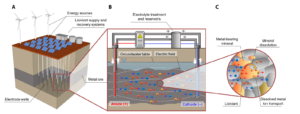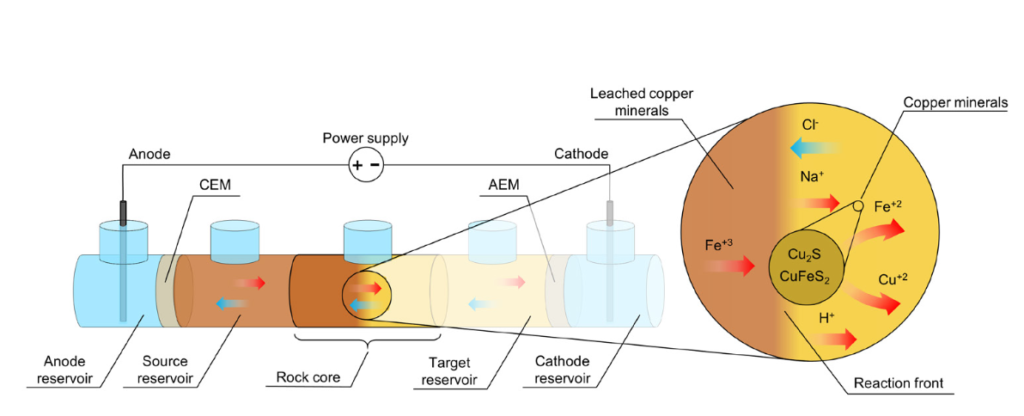A team of international researchers, including Dr Rich Crane from the Camborne School of Mines, University of Exeter, have developed a new method to extract metals, such as copper, from their parent orebody. The research team which also includes experts from the University of Western Australia, the Commonwealth Scientific and Industrial Research Organisation (CSIRO) and the Technical University of Denmark have provided a proof of concept for the application of electrokinetic in situ leaching (EK-ISL), utilising an electric field to control the movement of an acid within a low permeability copper-bearing ore deposit to selectively dissolve and recover the metal in situ.
This is in contrast to the conventional approach for the mining of such deposits where the material must be physically excavated, which requires removal of both overburden and any gangue waste material within the ore. The researchers believe the new technique has the potential to transform the mining industry, because it has the capability to dissolve metals from a wide range of ore deposits that were previously considered inaccessible. Furthermore, due to the non-invasive nature of the extraction, the research team are hopeful that the study will help usher in a more sustainable future for the industry. “This is urgently required now in order to provide the plethora of metals required to deliver green technology, such as renewable energy infrastructure and electrified vehicles, whilst limiting any potential environmental damage associated with the mining of such vitally important metals.”

The study was recently published in Science Advances with the attached schematic illustration of metal extraction from a subsurface ore body via EK-ISL. (A) 3D isometric view of an industrial-scale EK-ISL operation, including potential electrode configuration, above-ground energy source, lixiviant supply and recovery reservoirs, and metal recovery treatment facility. (B) Cross-sectional view of the ore interface between an individual anode and cathode. (C) Conceptual illustration of principal hydrogeochemical reactions between the lixiviant and the ore material when subjected to EK-driven electromigration
Dr Rich Crane from the Camborne School of Mines, University of Exeter, and co-author of the study, said: “This new approach, analogous to ‘key-hole surgery’, has the potential to provide a more sustainable future for the mining industry, by enabling the recovery of metals, such as copper, which are urgently needed for our global transition to a new Green Economy, whilst avoiding unwanted environmental disturbance and energy consumption.”
The central principle behind most modern mining techniques has not fundamentally changed since their original conception: metals are recovered from the subsurface via physical excavation, ie, the construction of tunnels to gain access to the deposits, or by creating open cast mines. This new technology comprises the construction (drilling) of electrodes directly into an orebody. An electric current is then applied which can result in the transport of electrically charged metal ions, such as copper, through the rock via a process called electromigration. The research team have now provided a Proof of Concept for this new technology at laboratory scale, which has also been verified using computer modelling. They are confident that the idea will work beyond the laboratory-scale.
As detailed in the Science Advances paper, Laboratory-scale experiments and process-based numerical modeling were used to assess the feasibility and scalability of EK-ISL for Cu extraction from sulfidic porphyry ore. Initial experiments were conducted using a synthetic Cu ore consisting of a homogenised mixture of quartz (80 wt % SiO2, <75 um) and chalcopyrite (CuFeS2) (29 wt % Cu, <120 um) powder. A 15 V direct current (DC) was applied over the length of the 96 mm-long reservoir hosting the synthetic ore mixture, and 0.5 M FeCl3 was used as the lixiviant. This resulted in the electromigration of Fe3+ (derived from the lixiviant) from the source reservoir into the Cu-bearing ore, wherein Cu dissolution occurred. Dissolved Cu, predominantly as Cu2+, was then transported into the cathodic target reservoir and measured using atomic absorption spectroscopy (AAS). “Our process-based numerical simulations cap-ture the experimental observations, which show that Cu recovery occurred rapidly within the first 3 to 4 days, followed by a slower phase. This is typical for Cu leaching operations and can be attributed to the passivation of chalcopyrite surfaces with elemental sulphur (S0) and/or low-pH stable iron hydroxide phases (eg jarosite) precipitates.”
Subsequent experiments comprised the use of an intact sulphidic porphyry Cu ore drill core sample [8.6 wt % Cu, determined by inductively coupled plasma optical emission spectrometry (ICP-OES) following borate fusion] with a diameter and length of 38 and 40 mm, respectively. Quantitative x-ray diffraction (QXRD) for subsamples identified chalcopyrite (18.2 wt %) and covellite (CuS, 2.6 wt %) as the main Cu-bearing minerals, with a minor quantity of chalcocite (Cu2S) (0.8 wt %). This correlates to 75, 21, and 4 wt % of the total Cu content present as chalcopyrite, covellite, and chalcocite, respectively. Nuclear magnetic resonance (NMR) determined the ore to exhibit a porosity and permeability of 10.6% and 6.1 millidarcys (mD), respectively. A 7.0 V DC voltage was applied, which resulted in an estimated potential drop of 5.0 V between either end of the core, yielding a maximal voltage gradient of 1.75 V/cm, similar to what is typically applied during EK-based soil remediation. On the basis of solution compositions determined by AAS and ICP-OES, 57 wt % of Cu was re-covered from its ore over 94 days.
Of the totally recovered Cu, 80 wt % (equivalent to 4.2 g Cu) was recovered within the first 50 days at a relatively constant rate. After this phase, the recovery rate of Cu gradually decreased. QXRD on the postleaching material identified that the amount of chalcopyrite had decreased to 7.6 wt % during EK-ISL and that all the covellite and chalcocite has been successfully leached. The recorded electric current decreased over the first 10 days from approximately 110 to 10 mA, consistent with temporary secondary mineral formation and associated blocking and/or narrowing of pores. This phase was followed by a period of recovery, which suggests pore widening, most likely due to mineral dissolution, to a final and relatively stable value of approximately 35 mA.











